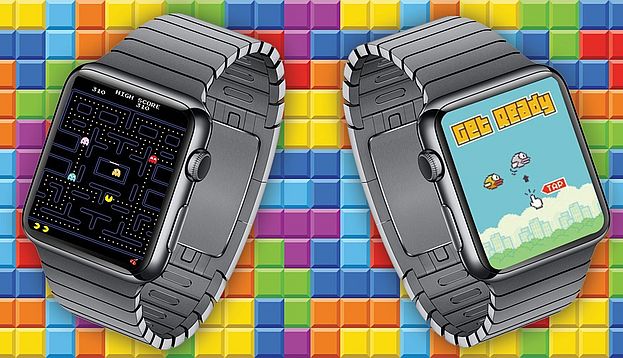With the Apple Watch slated to hit retail next month, many developers are no doubt hard at work on concentrated apps for the wearable device that will make proper use out of it. While most are focusing on experiences that relate to watch-style wear (such as the old-school Dick Tracy-style walkie talkie), some are actually working on games that can use the device in a number of innovative ways.
The Guardian recently posted an article where game developers explained how the Apple Watch can actually be a viable game platform, breaking down a number of ways that its use could innovative, through various experiences – and not just ports of Pac-Man and Tetris.
Obviously, the right approach has to be made, according to Will Luton, designer of the popular Pebble game Pixel Miner. “Integrating heart rate and pedometers obtrusively into game loops or attempting to shrink down smartphone titles onto a smaller device may get some traction early on as players explore the device and its capabilities, but they won’t be sustainable.
“The correct approach is to consider how the device is used and build from there. Smart watches are high frequency, short session devices that have low precision controls. This means that interfaces have to be very simple, such as one touch or menu-based systems. If smartphone games are designed to be played whilst waiting for a coffee, smart watch games should be designed to be played in an elevator ride.”
The article brought up a couple of examples of this, including mini-games from Nintendo’s Wario Ware series, which could be played in spurts with just a few simple motions and gestures, combining together into a larger game experience. There’s no doubt that developers would benefit from this format.
But that’s not all, as new ideas could also be explored. “One thing that game developers like is new modes of interaction and control,” said developer and researcher Michael Cook. “GDC ran their annual alt.ctrl workshop recently that’s all about new ways to interact with games. Apple’s already emphasizing these minimalistic ways of communicating through the watch, like doodling on the screen, tapping another person’s wrist remotely, and so on.
“The small screen and simple interactions also remind me of what Robin Baumgarten is doing in his game design experiments. Baumgarten’s latest creation is Line Wobbler, a game that you played on a single line of flashing lights. Designing games for really small platforms like a single dimension or a screen as small as a watch is a really cool challenge.”
“Persistent” games can also play a big part, allowing users to trade data with one another from a simple pass-by – similar to Nintendo’s StreetPass program for the Nintendo 3DS. “I do actually think there are some great possibilities for ‘persistent games’— games that you are playing all the time, alone or with friends,” says developer Bennett Foddy. “For these games, the watch makes it possible to check in on your progress whenever you have an idle nanosecond, without starting an app or pulling out your phone. These might be games that are played by tapping the phone at certain times, or by being at certain locations: the depth won’t come from the software itself but from the way that it fits in with your everyday life.”
“Developers will have to get better at placing more of the experience in the mind and less of it on screen,” says game developer Moo Yoo, who worked at Moshi Monsters creator Mind Candy until going independent. “I imagine a huge demand for highly interlinked social games and dynamically generated social narratives. You can take the example of a game like FarmVille which gave context and a real-world meaning to gifting a virtual animal. A smartwatch game could be a system of proposals, acceptances, and rejections – either in a dating sim or a game of diplomacy.”
More ideas on what Apple Watch gaming could be like can be found in this article here. It’s obviously got a ways to go, but developers can certainly find a way or two to make them truly innovate – and not just be “gimmicks”, as it were. If the Apple Watch and other wearables gain a large audience as many expect, this could be a significant new source of revenue for game companies who are, er, watching out for new opportunities.

